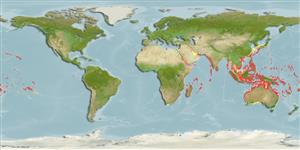Common names from other countries
>
Anguilliformes (Eels and morays) >
Muraenidae (Moray eels) > Muraeninae
Etymology: Gymnothorax: Greek, gymnos = naked + Greek, thorax, -akos = breast (Ref. 45335).
More on author: Shaw.
Environment: milieu / climate zone / depth range / distribution range
Ecologia
marinhas; Água doce; estuarina associadas(os) a recifes; intervalo de profundidade 0 - 51 m (Ref. 58302). Tropical; 38°N - 36°S, 18°E - 129°W
Indo-Pacific: East Africa (Ref. 33390) to Marquesas and Mangaréva, north to the Ryukyu and Hawaiian islands, south to Lord Howe Island. Southeast Atlantic: South Africa.
Tamanho / Peso / Idade
Maturity: Lm ? range ? - ? cm
Max length : 120 cm TL macho/indeterminado; (Ref. 1602); common length : 80.0 cm TL macho/indeterminado; (Ref. 30573)
Espinhos dorsais (total) : 0; Raios dorsais (total) : 0; Espinhos anais: 0; Raios anais : 0; Vértebras: 127 - 132. Mouth white inside, contrasting the outer dark skin with small white spots (Ref. 30404, 48635).
Occurs in coral-rich areas of lagoon and seaward reefs from depths of 1 m to at least 36 m. Prefers very shallow depth and juveniles often in intertidal zones (Ref. 30404). Benthic (Ref. 58302). Often seen hunting during low tide among partly exposed reefs (Ref. 48635). Feeds mainly on fishes, also on crustaceans, by day and probably also at night (Ref. 13550). Caught with various nets (Ref. 30573). Minimum depth reported taken from Ref. 86942.
Ciclo de vida ou comportamento de acasalamento
Maturities | Reprodução | Spawnings | Egg(s) | Fecundities | Larvas
Chen, H.-M., K.-T. Shao and C.T. Chen, 1994. A review of the muraenid eels (Family Muraenidae) from Taiwan with descriptions of twelve new records. Zool. Stud. 33(1):44-64. (Ref. 6934)
Status na Lista Vermelha da UICN (Ref. 130435)
CITES (Ref. 128078)
Not Evaluated
Ameaça para os humanos
Reports of ciguatera poisoning (Ref. 4690)
Uso pelos humanos
Pescarias: pouco comercial; Aquário: Espécies comerciais
Ferramentas
Relatórios especiais
Baixar XML
Fontes da internet
Estimates based on models
Preferred temperature (Ref.
115969): 24.5 - 29, mean 28 (based on 1172 cells).
Índice de diversidade filogenética (Ref.
82804): PD
50 = 0.5000 [Uniqueness, from 0.5 = low to 2.0 = high].
Bayesian length-weight: a=0.00059 (0.00038 - 0.00091), b=3.32 (3.19 - 3.45), in cm Total Length, based on LWR estimates for this species & Genus-body shape (Ref.
93245).
Nível Trófico (Ref.
69278): 4.0 ±0.70 se; based on food items.
Resiliência (Ref.
120179): Muito baixo(a), tempo mínimo de duplicação da população maior que 14 anos (Preliminary K or Fecundity.).
Fishing Vulnerability (Ref.
59153): High to very high vulnerability (72 of 100).
